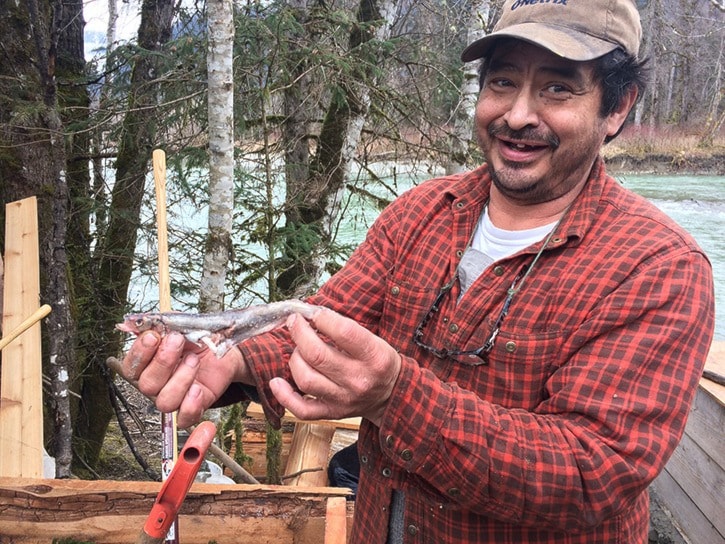There’s a distinct odour wafting from the edge of the Bella Coola River near Tatsquan Creek. It’s something that is so familiar to so many, and yet so foreign.
20 years ago ooligan disappeared from the Bella Coola. To many, the sudden vanishing of the precious “candlefish”, or sputc as it’s known in the Nuxalk language, seemed to happen overnight. One year they were there, the next they weren’t.
On the riverbank today sits a large cedar “stinkbox” filled with four thousand pounds of ooligan. Although these ooligans were bought from the Kincolith Band on the Nass River through a special initiative, Nuxalk people are still rejoicing at the sights, sounds and smells as the stinkbox returns.
Several elders are working alongside teenagers, children from all of the local schools and daycares have been coming by the site, and visitors pop in all throughout the day to witness a ritual that was once such a part of the yearly routine, but is now so rare.
The camp is buzzing with energy and laughter as people continue to stir the fish, gather water, make food or just simply relax inside the makeshift tent and enjoy a cup of coffee among friends. It’s a non-stop process that once started cannot finish until all the fish are done, and four thousand pounds means nearly a week of dedicated cooking.
A fire is dug into the earth and a large wooden box sits on top, the water slowly bubbling the ooligan all day long to draw the grease from their bodies.
Everyday a new batch starts cooking in the early morning and runs until late evening, when the grease is finally ready to skim from the surface and the bodies of the little fish are mashed to a paste. Estimates are for about 80 gallons of grease, which will be jarred by Acwsalcta students at their traditional foods program and distributed at the school’s potlatch this spring.
“You can’t have it at a rolling boil and you can’t have it too cold,” explained elder Frank Tallio. “Otherwise the grease will go back into the fish.”
Bert Mack, one of the younger generation who still know hows to make grease, says he remembers when people used to clear out of the way when they smelled the cookers coming, the smell of ooligan was so strong.
“They’d move us through that grocery line so fast,” he remembers, his joy at the bubbling ooligan so tangible you can feel it radiating from his smile, like heat from the fire.
“It’s our medicine,” he explains, dipping his fingers into taste the grease. “It’s what we used to prevent disease and keep us healthy.”
The health benefits of ooligan grease have been well documented. Called the “saviour fish” as it was the first to show up in the river systems after the long winter months, ooligan grease is a rich source of omega-3 fatty acids which help protect against diabetes and strokes. It was traded among First Nations for thousands of years and provided huge wealth and power to the people of the Coast.
“We want our children to learn from our remaining elders how to make grease. This means so much to our community,” said organizer Marlene King. “Since we lost our ooligans, sickness has stricken our people. Our immune systems have gotten weak because we have no grease. We used to cook bannock and a lot of our foods in the grease at the ooligan camps. Our elders were so strong and hard working, and I believe it was because of our grease.”
Megan Moody, a Nuxalk scientist who has devoted much of her life’s work to studying ooligan, says that arrival of shrimp trawlers in nearby Queen Charlotte Sound, coupled with the changing climate, appear to have contributed to their spectacular disappearance in 1998.
“Ooligan bycatch was a huge problem for the shrimp trawlers in Queen Charlotte Sound,” explained Moody in a 2014 interview. “There are estimates that between 90 and 150 tonnes of ooligan was being caught as bycatch by the trawling industry.”
Alterations have since been made to help the trawling industry avoid the enormous bycatch, but the Bella Coola run hasn’t yet recovered. Other communities on the central coast lost their ooligan earlier, such as Wuikinuxv. Further north, the Nass and the Skeena, are still enjoying relatively healthy runs.
Recovery is possible, however, and Moody remains optimistic that stocks can bounce back. She believes that the relatively small size of the Bella Coola ooligan stock has contributed to its decline, and it will naturally take longer to replenish once the numbers have gone below a certain threshold.
While many lament over the loss of a key food source that is so undeniably healthy, the cultural loss may be even bigger. Grease making time was when the community would come together; each family preparing it according to their own preference, but all alongside one another on the banks of the river. Cultural knowledge was passed on from generation to generation, with children working alongside elders as they learned the ancient art of making grease.
“This is an opportunity for our community to work as one,” said King. “Our intent is to provide the knowledge for our people especially our children.”
Nuxalk organizations such as NAALS, Chief and Council, Nuxalk Wellness, Lip’Alhayc College and Copper Woman Society Grant funded the project.
“We thank everyone from the bottom of our hearts to have made this possible, and to thank all the knowledge keepers and everyone who participated in the project,” said King. “We will be working on grants for next year to ensure it happens again.”
The ooligan will be celebrated once again this year as the Sputc Ceremony returns to the community for the third time on Sunday, April 9. The ceremony starts at the Sputc Pole at 11:30am on the banks of the Bella Coola river and all are welcome to attend.
